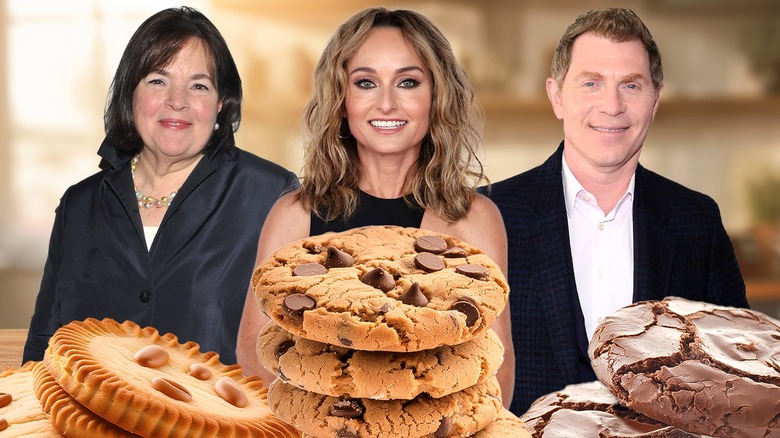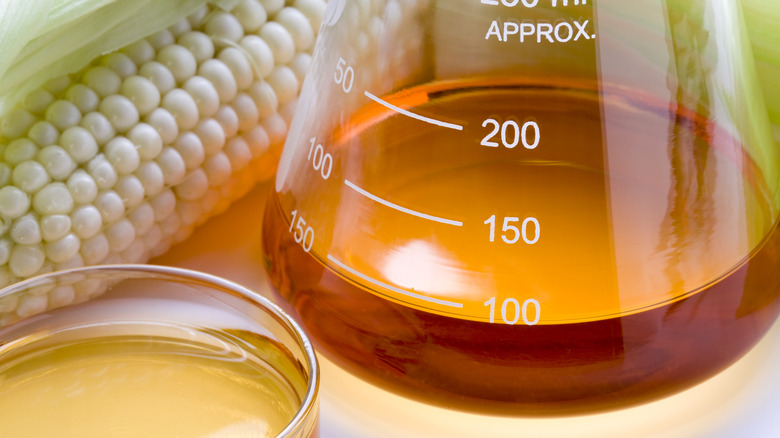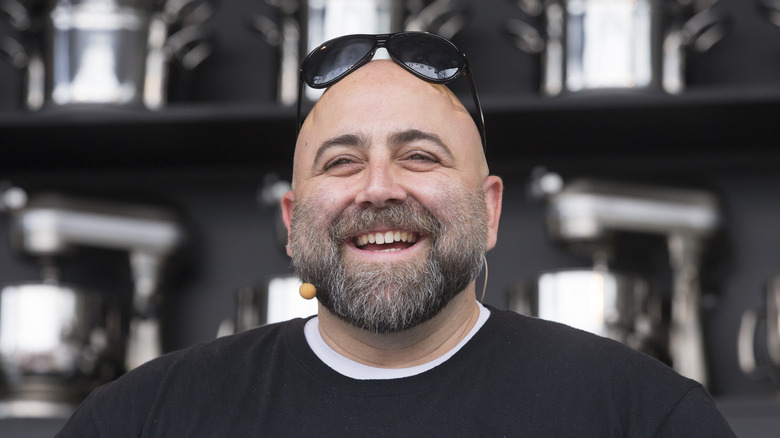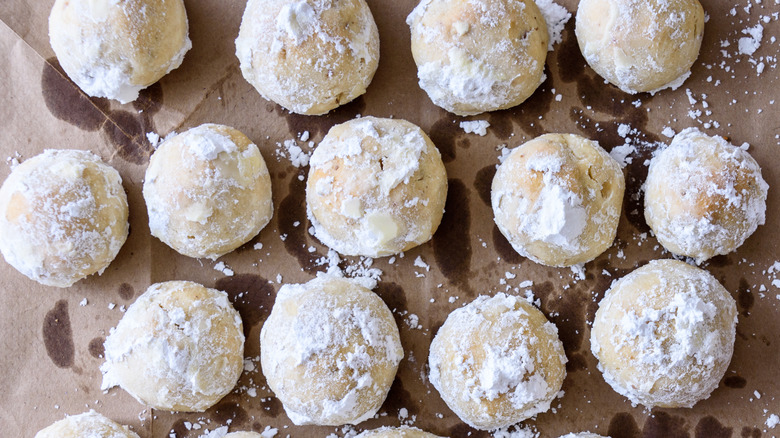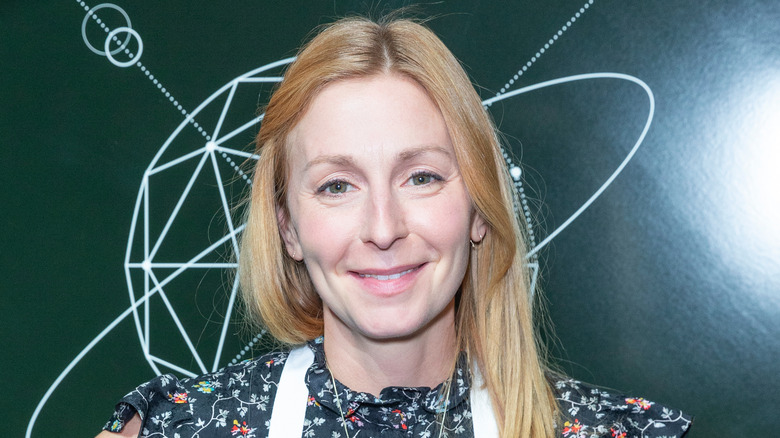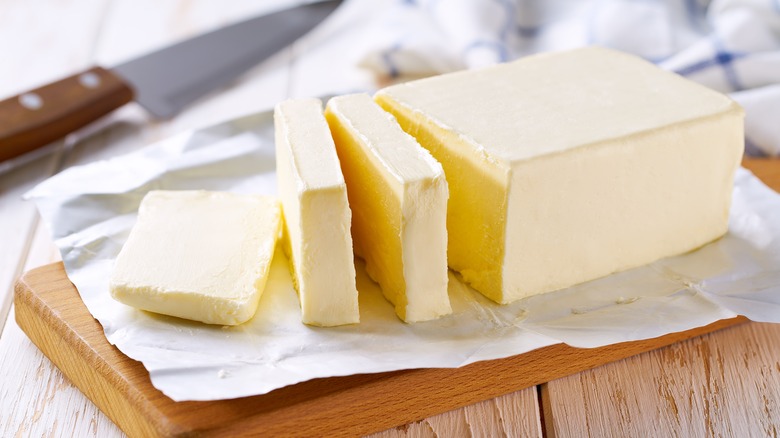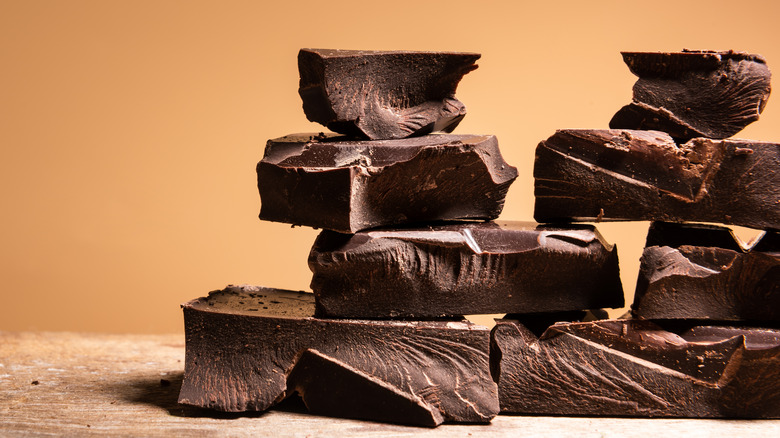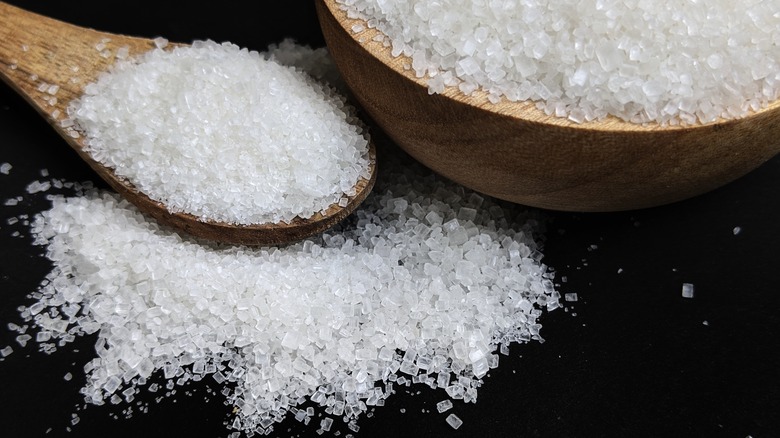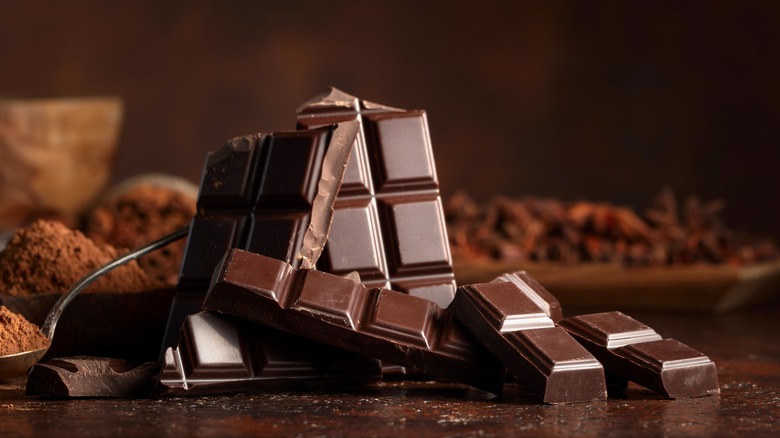14 Celebrity Chef Tips For Baking Outstanding Cookies
We may receive a commission on purchases made from links.
Baking homemade cookies is one of the most rewarding experiences in the kitchen. The whole house starts to fill up with that sweet and welcoming scent, and the excitement of biting into a warm, gooey cookie is almost too much to bear. But these lofty expectations can also cause great disappointment if the cookies don't turn out so well. Baking cookies is not the most challenging or technical feat, but it is possible to get it wrong or to end up with something mediocre.
That said, you are less likely to fail if you look to the advice of the professionals. This is why we've put together a list of tips from top celebrity chefs for baking outstanding cookies. Following these guidelines might be the thing that gets you from sub-par brittle cookies to perfectly chewy nuggets of pleasure. These chefs understand the nuances of how ingredients interact with each other and with heat, allowing them to tweak recipes accordingly. For instance, understanding how the consistency of butter or the act of chilling dough before cooking can affect the cookies is paramount to baking the perfect dessert. The same is true for any unusual ingredients you may want to experiment with. Knowing the difference between what works and what doesn't can transform your baking from good to extraordinary. So, let's look at some of these tips and find out how to apply them to your next batch of cookies.
Ina Garten freezes her cookie dough for 15 minutes
Food Network star Ina Garten is widely known for her approachable cooking and baking methods. Not only are her recipes delicious, but they're also relatively easy to make, even for the amateur cook or baker. Then, it should come as no surprise that one of Garten's top tips for making outstanding cookies is an easy step that anyone can do as long as they own a freezer.
Indeed, Garten's trick is to freeze the prepared cookie dough for about 15 minutes before it goes into the oven. Be sure to mold the dough into bite-sized rounded scoops before you put them in the freezer, or you may have to wait for the dough to thaw and soften a bit before working it, defeating the point. It will help the fat in the cookie dough solidify so that once it is heated in the oven, it will spread less and result in more voluminous, chewy cookies. So next time you embark on a cookie-making venture, wait to preheat your oven until you've put the cookies in the freezer.
Giada De Launretiis frosts her cookies with Aperol
Aperol spritzes and their many variations seem to be all the rage these days. Versions have cropped up in bars across the world far afield from their original birthplace in Italy. But cocktails are not the only way to use Aperol, as TV star Giada De Laurentiis has shown. In fact, De Laurentiis also uses Aprol in desserts, specifically to frost her ricotta cookies, turning relatively plain cookies around with a sophisticated flavor of slight bitterness coupled with sweet herbiness — the perfect foil to the richness of the butter and ricotta.
De Laurentiis' trick is to use a small amount of Aperol in the cookies themselves, which can also contain orange juice and zest, and a bit more in the frosting. It will give the frosting an extra punch of flavor and orange color. Serve these Aperol-glazed cookies for dessert or even as part of your aperitif. After all, that is what Aperol is for. Just don't eat too many of them, or you'll spoil your appetite and defeat the purpose of the appetite-whetting liqueur.
Bobby Flay bakes his cookies in electric ovens
Bobby Flay is known more as a chef than as a baker. Most of his recipes are savory Italian dishes or bright, spicy southwestern meals. But that doesn't mean he doesn't occasionally dabble in baking, and given his expertise in the kitchen, we're guessing his attempts are wild successes.
One way Flay ensures such success is by baking with an electric oven. Although chefs worldwide sing the praises of gas stoves due to their ease of temperature control, the same cannot be said for gas ovens; their temperature cannot remain as stable as an electric oven once the desired heat has been reached. In other words, what proves to be a strength in the cooking department is a weakness in baking. Another reason Flay says electric ovens are better for baking is they tend to produce a drier heat that is distributed more evenly throughout the oven. It helps prevent burning the bottom or top of your cookies, which can happen when all the heat comes from the bottom or top of the gas oven.
Andrew Zimmern adds corn syrup to chocolate chip cookies
You may have heard that baking is an exact science: If you mess with the measurements of just a single ingredient, you could end up with a very different result from what you got the last time you made a recipe. This is why it's important to know your stuff — or your science — if you plan on switching up the ratio of ingredients.
Luckily, award-winning chef Andrew Zimmern knows his science. While some recipes call for the same amount of granulated sugar and brown sugar or less brown sugar than white sugar, Zimmern makes his chocolate chip cookies by increasing the ratio of brown sugar. Not only that, but he also adds a touch of corn syrup. The result is cookies that are both chewy on the inside and crispy on the outside because all three sweeteners worked in concert. And it seemed that after much trial and error, he succeeded for purely scientific reasons: Brown sugar contains a higher moisture content than white sugar, which gives the cookie a chewier, softer consistency (this is especially true if you slightly decrease the baking time). At the same time, white sugar will allow the cookie to spread and make it crispy, and corn syrup will create a chewier texture.
Duff Goldman soaks oats and raisins before making oatmeal cookies
The oatmeal raisin cookie seems to have gotten a bad rap in recent years. Maybe it's because of a shift in generational preferences or because raisins are just passé, but it appears kids these days would rather have an oatmeal cookie with no raisins in sight.
Luckily for traditionalists, pastry chef Duff Goldman and his oatmeal raisin cookies have set out to change this state of affairs by adding a simple and easy extra step: Goldman soaks the oats and the raisins before doing anything else. This move will rehydrate both ingredients, adding moisture to them, which in turn will produce chewier cookies with a more even consistency. The plump raisins will no longer be sad, dry bits that get stuck in your teeth but will join in concert with the oats. Raisins are still a mainstay in the oatmeal cookie recipe despite all the flak they get because they play an important role in the cookie's overall flavor profile. In the midst of the sweet, spicy, and warm oats, the raisins provide a pop of acidity and brightness. This is no small feat. The trick is just about getting the texture right.
Martha Stewart adds bourbon to her nut ball cookies
As winter approaches, you may be on the lookout for the perfect winter cookie to serve your guests. Nut ball cookies, which are extremely rich in butter and often covered in powdered sugar, which evokes a dusting of snow, are an ideal recipe for this time of year. And frankly, it's hard to find a bad nut ball cookie recipe out there, as it's an almost foolproof endeavor.
That said, there is a way to make your nut balls even better, and cookbook author Martha Stewart knows how. Stewart likes to add bourbon to her cookies, which is how her family has traditionally made them, giving them a special kick that is especially welcome on those cold winter nights. Just add the bourbon to the butter and sweetener mixture before you mix in the dry ingredients. If you're making these for kids and don't want to include alcohol, Stewart suggests substituting the bourbon for a bit of orange juice.
Christina Tosi always bakes a test cookie
If you hate food waste above all else, you might like Milk Bar founder Christina Tosi's tip for getting your recipe right before committing to an entire batch. Indeed, as she told People, Tosi recommends baking a single test cookie from newly prepared dough to ensure you achieve the right texture and consistency. For example, if you burn your test cookie or it comes out too soft, you'll know that your oven temperature or your cooking time needs to be adjusted.
Other adjustments you can make are the size of the scoops of dough or whether or not to ball them up more or push them down. While you can't necessarily mess with the flavor of your cookies at this point, as the dough has already been made and adding ingredients here could alter the chemical reactions among them, you will certainly get a better idea of how to handle your oven settings to produce the best possible cookie.
Ina Garten softens her butter to perfection
It has happened to the best of us. You crave chocolate chip cookies; you've been planning on making them for days, but you've just realized your butter is still sitting in the fridge in a cold, unyielding block. Now, you have to take it out and wait a few more hours for it to soften to room temperature.
But Food Network host Ina Garten, for one, doesn't have to do this. That's because if Garten knows she's going to make cookies the following day, she takes her butter out of the fridge the night before. It allows the butter plenty of time to soften to the desired temperature without going overboard or melting, as might happen if you try to soften it in the microwave. Soft butter will help you cream it more easily, which is what many cookie recipes call for, while cold butter tends to mix less evenly. Meanwhile, melted butter tends to lead to a greasy cookie. But don't worry about your butter going bad while you leave it out overnight. Butter contains a lot of fat, which keeps it fresh for several days even when not refrigerated.
Alex Guarnaschelli adds the flour last
The ingredients you choose to put in your cookies, including their ratios, matter a lot for the end product, but the order in which you add them also matters. This pearl of wisdom comes from Alex Guarnaschelli, who adds flour toward the end of the cookie dough-making process. She explained on Good Morning America that adding flour too early can result in it being overworked, which would develop the gluten more than desired, leading to tough cookies — a great quality in a person, but not so much in an actual cookie.
So next time you set out on a cookie-baking venture, mix all the other ingredients first, saving the flour for last (or just before the chocolate chips, nuts, or whatever else you plan on adding as accouterment). And when you do finally mix in the flour, don't overdo it. If you're using a standing mixer, stop the machine as soon as everything is blended uniformly, or better yet, fold the flour in by hand.
Jacques Torres uses 60% dark chocolate
We all love a good batch of chocolate chip cookies. Many of us have probably made this recipe more times than we can count. But does everyone remember what type of chocolate they used? Many recipes call for bittersweet chocolate, which is usually about 70% cacao, placing it firmly in the realm of dark chocolate. Some bakers might balk at the bitterness level and go for a bag of milk chocolate chips instead or even white chocolate or peanut butter chips.
Seasoned chef Jacques Torres likes to take the middle road and add 60% dark chocolate to his cookies. As he says in a Goldbelly YouTube video, he's been making pastries for more than 45 years, so he knows a thing or two about chocolate, which he calls the most important ingredient in his recipe. He also likes to use a slightly different shape of chocolate chips. His are wide, round, and flat to make them "melt and create layering inside the cookies," he says, "That's what makes these cookies pretty different and exceptional." But whatever chocolate you end up choosing, Torres stresses that you must select high-quality ingredients, which, according to him, are the only means of achieving a top-notch cookie.
Alton Brown uses bread flour
Most chocolate chip cookie recipes call for all-purpose flour, and what could be simpler than that? The name says it all: This flour can literally be used for all purposes (just within baking and cooking, we assume). But celebrity chef Alton Brown doesn't always play by the rules, which is why it's no surprise that Brown uses a different kind of flour to prepare his cookies: bread flour.
Indeed, instead of all-purpose flour, his recipe calls for 12 ounces of bread flour, which makes the cookies chewier than their traditional counterparts. It's no accident that this cookie recipe is called "The Chewy." Bread flour manages this effect because it contains a slightly higher amount of protein than all-purpose flour, which, in turn, increases the elasticity in the dough without significantly altering the texture or flavor of the finished cookie. If you've been trying any trick you can think of to make your cookies chewier but haven't quite managed yet, try this. It might be just the ticket.
Joanne Chang uses less sugar
We all love to snack on a bit of sugar after a meal or throughout the day, but some items these days just seem to have too much of it. In fact, some baked goods contain so much sugar you can hardly taste anything else. Restaurateur Joanne Chang fixes this problem by adding less sugar than a recipe calls for when she makes cookies. But beware: She doesn't just use a random amount of sugar, as this could interfere with the overall chemistry of the cookie and result in something with an entirely different texture and flavor.
Instead, in Chang's book on baking, titled "Baking with Less Sugar: Recipes for Desserts Using Natural Sweeteners and Little-to-No White Sugar," many recipes for cookies, cupcakes, and the like call for about half as much sugar as you might normally find. It preserves the integrity of the baked good while allowing other ingredients, like chocolate or blueberries, to stand out. Chang's book also provides recipes for those who want to do away with sugar altogether, with plenty of options to use other natural sweeteners like honey or maple syrup.
Valerie Bertinelli uses caramel chunks in chocolate chip cookies
They say that if it ain't broke, don't fix it, and there is certainly nothing broken about the traditional chocolate chip recipe. But sometimes it's also nice to branch out and inject a bit of variety into things. That's where TV personality Valerie Bertinelli's chocolate chip and salted caramel cookies come in. Her recipe is close enough to the traditional one that it shouldn't be considered "fixed," but it also adds more depth with the caramel bits and a salty edge with the sea salt flakes.
But beware: According to Bertinelli, you can't use just any kind of caramel bits, even if they're of really good quality. The risk is that it could melt in the oven and cause the cookies to burn around the edges. Instead, use Kraft caramel bits, which hold their shape in the cookie even when baking. And don't forget to sprinkle salt on top of the cookies before putting them in the oven. That's where the salted part of salted caramel comes in.
Paul Hollywood hides a chunk of chocolate in the middle of the cookie
Paul Hollywood of "The Great British Bake Off" has been cooking pastries — or judging them — for practically his entire career. So when Hollywood gives us a tip on how to make better cookies, we listen, especially when it's a simple task that any amateur can do.
In fact, this tip is so easy you might wonder why you haven't thought of it yourself. All it involves is hiding a slab of chocolate (or your ingredient of choice, such as caramel or peanut butter, as long as it melts in the oven) smack in the middle of your ball of cookie dough so that when the cookie is done and split in half, a burst of gooey chocolatey goodness pours out. You can do this quite simply by fashioning your ball of dough, then punching a little hole in the middle, adding the chocolate, and closing it up when you're done.
